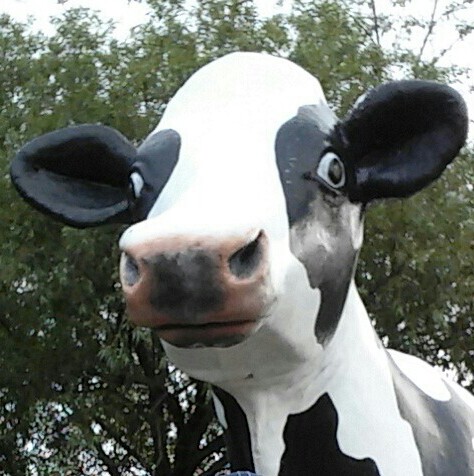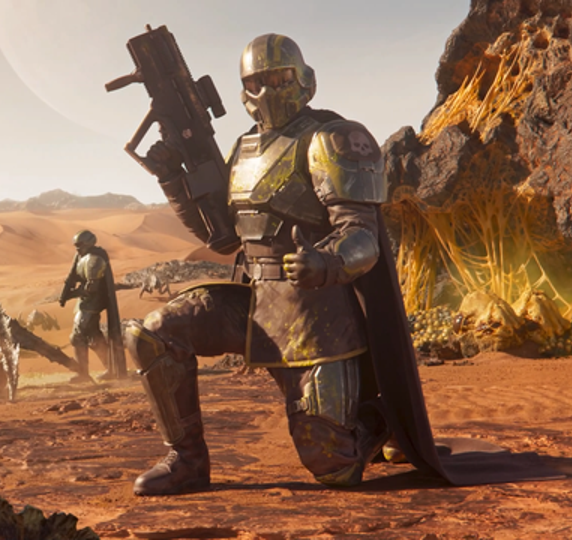Thoughts and prayers have a better chance of success
This is literally what happens when a volcano erupts. Magma solidifes at the top and creates a plug, which builds pressure until it explodes.
Dude, you are going to break this person’s heart. Keep this knowledge to yourself.
Bobby, if these kids could understand volcanic geology, they’d be very upset right now.
Now we have lava and a cement projectile!
Hold on a sec… what if just aim the volcano at our enemies?
Putting a gun barrel on the top of our volcanoes and just randomly waving it around at other countries lol i love it
I feel like with the direction of fire that’s more of a penis than a gun. I’m on board let’s do it!
It’s a shame we can’t grow a large enough potato.
Not with that attitude
I like how the diagram contains an illustration of one of the flaws in the plan
I’m sure Super Glue would work too.
God: What the fuck are they doing down there bro
why not like pour water on the volcano, my dude
Volcano erupting? Just tell it to stop. It legally can’t erupt without your permission.
A fellow Jedi
WOKE
Just put up some “no eruption” signs.
The sign won’t do much good without force of law. We need legislation outlawing these eruptions.
That goes without saying. We need to regulate volcanic burp strength, ejaculation mass and toxic fumes. Pyroclastic flows as well.
But if we regulate burp strength, ejaculation mass, and toxic fumes, my husband won’t have any hobbies left!
That’s harsh. He might get a permit if he promises to not kill entire villages at a time.
We still talking volcanos or have we moved on to regulating Taco Bell and porn?
I see no reason to differentiate
That’d be about as ridiculous as the proposal that is being dismissed into oblivion in this thread but at least economically and technically feasible.
Three or four signs should suffice.
Oh I get it! If you stack rock on the hot rock, you can stop the hot rock from moving the rock with more rock!
… Unironically, this DOES work … sorta’. Though it’d be dumb to do by man, because a ‘rock plug’ is exactly what forms at the top of many volcanos after the magma cools. It’s why many volcanos have flank eruptions where magma pushes through some side crack, or build and build until the rock plug pops catastrophically.
Of course some volcanos don’t have the right mix to form rock plugs, and any non-dormant volcano can pop them, but the point is it does have an effect that can delay and redirect eruptions.
If humanity doesn’t kill itself off soon (bad news on that front), I wouldn’t be surprised if one day we’re building megastructures around volcanos specifically to manage them instead of being subject to them.
Well I think it’s more the case that the lava finds the weakest spot to push through. That can change over millennia.
The chances that you will create a concrete block that’s stronger than the next weak spot is pretty slim.
Yes, exactly on the idea. “The weakest spot” is distinctly NOT the hunk of solid rock cooled at the top, more often than you clearly think.
It doesn’t have to have a huge effect to never the less completely change the nature of an eruption. Just look at Mt St Helens. The top didn’t even have to pop. The magma just lubricated the side of the mountain enough until the whole damn side slid away, allowing the eruption to occur.
They don’t often redirect every eruption, becuse many have NO other weak paths, so the magma pushes, and it either pops the rock plug or melts it. Not that many eruptions start fast enough to catastrophically pop the plug, and not all eruptions are remotely equal.
My point was NOT that the plugs make a HUGE difference, but that they make A difference.
If we were really ambitious could we harness geothermal energy to such an extent as to prevent major eruptions if we could predict them?
Maybe not geothermal per se, but something would be possible, with unlimited budget and resources.
Though the problem is just how MUCH energy volcanos have. Heat content is A LOT of energy. The vast (on a human scale) magma chambers contain an insane amount of energy. Rock has a heat capacity less than water by weight, but rocks weigh a lot more than water and can get a lot hotter.
So, it’d have to take away a TON of heat, likely more than humans use in a year for a single small eruption, but I’m too lazy to do the math right now…
Also, many eruptions are fueled by pressure from dissolved gasses in the magma. That pressure will stay present until the magma cools enough to resist it itself, which could require dropping an entire underground lake of lava by hundreds of degrees.
Then there are undoubtedly some eruptions that are driven by tectonics, meteor impacts, and other physical pressures that might not be manageable via heat control at all.
Rad. That’s probably a level of energy harvesting between fusion and Dyson sphere.
I think there are much easier ways to get massive amounts of power than try to interface with such an incredibly chaotic and unpredictable system.
An even bigger problem though is that most of the time geologists really have to aggressively make the case to anybody that their work is valuable when it isn’t directly contributing to finding oil or evaluating groundwater reserves.
Studying volcanoes, even in places with lots of volcanoes, is considered kind of a dubious practice by most people and taxpayers. Yeah sure, Mount Saint Helens goes off and all of a sudden people will take volcanoes very seriously for a bit, but generally people don’t give a shit about geology even if they haven’t been infected with “the earth is only 10,000 years old!” brainworms.
I mean, geologists will give a warning like “well, we could all die with no warning anytime from now through the next 50,000 years so we are very very due for a catastrophic eruption and we need to prepare!”.
Like yo, we can’t even agree to fucking give universal healthcare to people in my country…. sigh.
Haha, that’s pretty cool. Is there anything written about this?
Absolutely TONS of info, though I’m not a geologist, nor have I studied much, so I sadly do not know of any solid references I could simply point at. I’ve just picked up a few details over the years watching random geology videos on YouTube.
GeologyHub makes frequent short videos on current activity, and he always comments on the mechanisms at play, and even makes and explains his educated guesses on what will happen. A plug forming comes up quite often when eruptions slow, even in eruptions that are destined to continue erupting.
If pressure builds up we won’t riaj anything because the cemenbt would just be propoulksed in the outter space and not hurt anyone.
 's brilliant plan for reaching Mars
's brilliant plan for reaching MarsDamn straight! Gotta teach those space bugs a lesson about messing with Buenos Aries.
Big volcanoes look like this

(Mount Rainier, Washington)
The BIGGEST volcanoes look like this

Or this
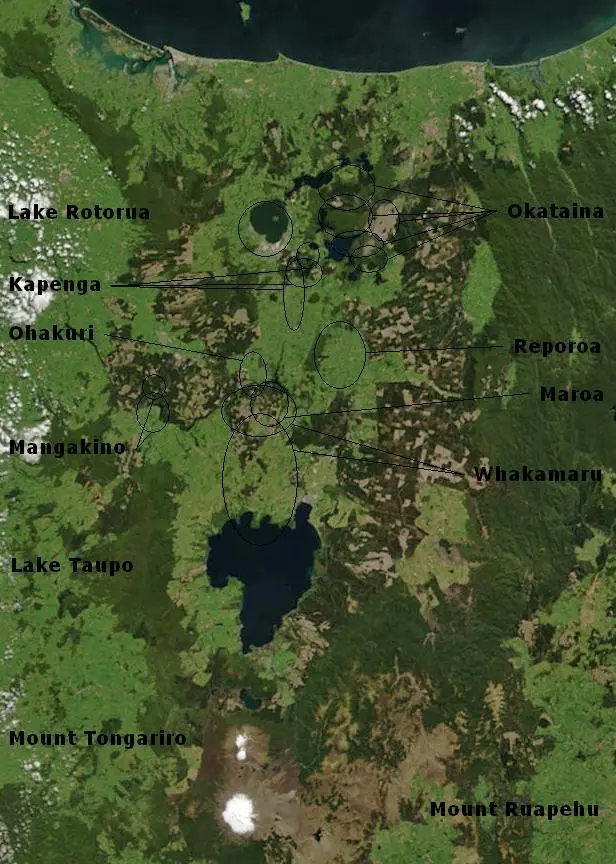
Notice how they don’t have that nice big pretty volcano cone shape? It just looks like some drunk geologists scribbled on a map and drew circles around a low lying area with a lake or two in it and called it a “volcano” or a “volcanic zone”.
The reason though is that the BIGGEST and most destructive volcanic eruptions tend to happen with lava/magma that doesn’t flow very well and like when you get a stuffed nose, everything gets blocked up. Like many of us, these volcanos don’t solve the problem and go take a decongestant or blow their nose, they just sit there sniveling and stewing, failing to release the pressure that keeps building and building and building.
These eruptions are called felsic reactions (the opposite of mafic, goopy eruptions you have seen footage of from Hawaii where the lava comes out like a fluid). An immense amount of gas is released by magma as it becomes exposed to the surface (which then we call it “lava”) as the gas is no longer kept in the magma at immense pressures. The magma can’t flow and “pass the gas” so to speak so a plug forms and what you get is a terrifyingly big pressure cooker that just builds and builds like that person on the plane next to you that just keeps sniffing and sniffing and never blowing their nose.
When the built up pressure finally overcomes the plug, the resulting explosion is so catastrophic it doesn’t leave a clean volcano shape. What you are left with is an uneven low topography dotted with lakes that marks the site of an incomprehensibly large explosion, hence the topography of Yellowstone, Wyoming and the Taupo Volcanic Zone on the North Island of New Zealand.
Except Vesuvius, which looks like a volcano, but in 79CE erupted violently sending lave, magma and molten rocks several kilometers away, exactly like the stuffy nose you described. It completely destroyed Pompeii and Herculaneum, burying them for thousands of years.

Still nothing when compared to the destruction that the “Campi Flegrei” volcano brought 37’000 years ago, completely burying a huge section of the Campanian coastline.

Super cool!!
Aain I love how it looks like a drunk geologist made a big scribble on a map and said before passing out “that Campi Flegrei, that’s a BIG one right there!” and you are just left looking at the map being like… what… are you sure that just looks like you randomly circled a huge part of the landscape?..like… really the whole bay?
Yeah, it pretty much blew out that whole section of coastline, that big hole is called a “caldera”. It’s still active btw, you can go and check it out if you want. Look for Solfatara di Pozzuoli.
You can also look at the Greek island of Santorini, where the whole western and central part of the island was blown off during the bronze age iirc. Historians speculate the eruption, earthquake and tsunamis caused by the event could have partially influenced the collapse of the Minoan civilization, the rise of the Mycenaeans, turmoil in Egypt and possibly even the fall of the Chinese empire due to a global winter. Crazy stuff

Ohhh, I had no idea there were different kinds of volcanoes but it does make sense in hindsight.
Well, I guess this might have been covered in primary or secondary education at some point but it’s been about 3000 years since my last geography class
There is a wonderful diverse world of volcanic eruptions! One thing you might not have thought about is how glaciers often form at the top of large cone volcanoes and the way the lava erupting interacts with a large volume of ice can shape the eruption significantly. One of the biggest results are lahars, like muddy, liquidy avalanches but even faster and deadlier.
To give you a good point of reference though, one thing that links all volcanic eruptions and is a good axis for comparison between different eruptions and volcanoes is that all magma pretty much comes up from the mantle to the near surface starting at the same chemical composition (called “mafic” it sounds like “basic”). Mafic minerals are heavy, dense and tend to be dark colored when viewed in a hand specimen, a common mafic rock is Basalt. Felsic minerals tend to be light both in mass and in coloring, a comon felsic rock is Granite.
Here is something to ground these two ends of what probably seems like a really arbitrary, technical spectrum of phenomena, the Oceanic Crust (i.e. the bottom of the ocean) on this planet is overwhelmingly made up of mafic rocks (i.e. Basalt) and large amounts of felsic rocks only really form on continental plates where there is the space and depth of rock to house massive chambers of magma, especially since Oceanic Plates are always getting subducted and recycled unlike Continental Plates (and thus the magma might be subducted & recycled before it could even begin the process of becoming significantly felsic). This axis of chemistry is critical to Geologists because it points directly to some of the biggest trends of geology on the planet and a related fact I might as well drop here is that because of these dynamics Continental Plates (i.e. basically the continents) can be orders of magnitude older (on the order of 1 billion years or older, the earth is only 4 or so billion years old) than oceanic crust which tends to be younger than 200 million years old (and often is much younger).
On Continental Plates if magma feeds into large underground chambers (batholiths) and is allowed to cool slowly then certain minerals will begin to form and precipitate out like snow that layers up on the bottom of the chamber. The specifics of what minerals these are depends on how long, how hot, how much pressure and other factors but you can vaguely think of it as a process of distillation where magma progresses from the original “mafic” composition to a “felsic” one as the high temperature mafic minerals crystallize out leaving behind the felsic magma mixture. The felsic minerals don’t crystallize out until the magma has significantly cooled and thus if the magma undergoing this process in a chamber is integrated into an eruption, it can become extremely explosive and destructive.
This is a graph of Viscosity, the more Viscous the Magma the less ability it has to flow like a liquid (and thus the more likely a plug is likely to form inside a volcano). It is also more difficult for lower temperature magma to flow, and Felsic lava is almost always lower temperature (cooling had to occur to become Felsic in the first place so).
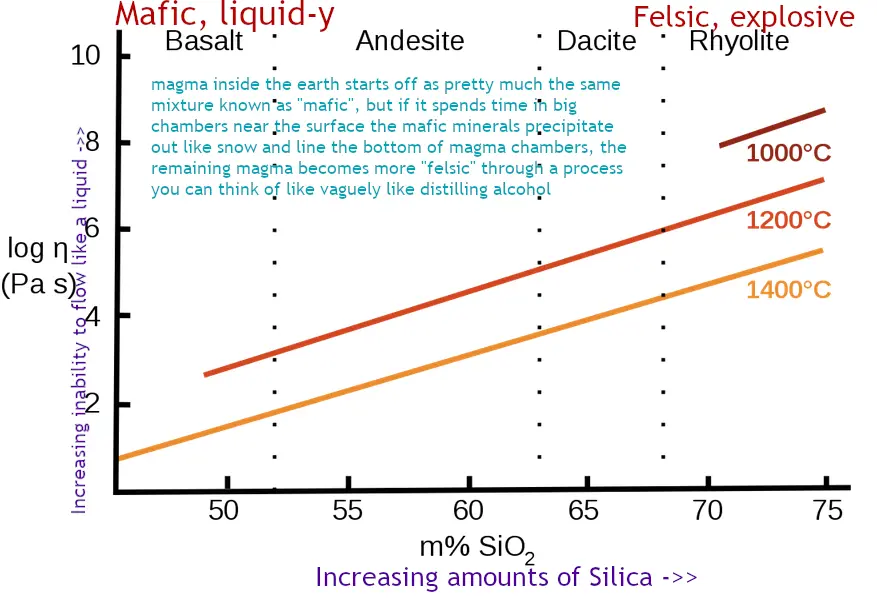
Huh, interesting. I didn’t expect to learn about volcanoes today but here I am! Thank you for the explanation
Made me whip out my geology notes I took a few semesters ago, thanks for the fun explanation
Hell yeah!
I’m currently in college getting my major with something in education and that comment, that’s the energy I want to capture
So you are saying we need more concrete?
Paving over all of Yellowstone is the only right answer.
Yeah, we could build a Walmart there too!
We will need to send the best managers Walmart has to offer to keep the volcanoes in check
And expedite it, we only have a couple of million years to finish the job.
They paved paradise and put up a parking lot.
No no no, we need to dig down to the magma to release the pressure!
With a valve, I guess, to release the pressure gently
No. Bore through all the way to the other side so all the magma just drains out.
Time to invest in concrete companies. The demand is going to be HUGE!
Thank you, kind geology enthusiast.
Really barely comprehensible how immense those volcanic activities are.
On a side note, you’ve listed insane unit after insane unit of death and destruction. And then there is this sentence:
There is evidence that it occurred on an autumn afternoon
That was a cute turn and I laughed. :D
Thank you that was super informative. Is there anything that can be done to mitigate an impending eruption? Ive always heard that if one of the big super volcanoes goes it could be quite catastrophic for the entire world. Surely theres been some research into like pressure relief holes or something…antacid tabs?
Surely theres been some research into like pressure relief holes or something…antacid tabs?
I am sure there are lots of geologists who have thought of it, it makes sense right?
The problem is that nobody gives a shit about listening to geologists unless they are talking about where to find oil. Even if a geoengineering project of this scale and magnitude (with such catastrophic consequences if it goes wrong) where possible with near current geological science and hardware this degree of interest and investment of society is only ever committed to visions techbros provide and I don’t think a single techbro has ever taken a geology class and actually remotely paid attention.
It was geologists in the 1970s who first pointed out the obvious connection between human released CO2 emissions and global warming.
Nobody gave a shit :)
We are just weirdos going on about rocks except when those rocks are really valuable and provide the capacity to create empires but even in those cases we are never really part of that, we are always still the weirdos going on about rocks who everybody is like “ok but can you shut up now and point to the gold on the map?”.
You are right sadly :( but dont discredit yourself so much! A ton of people do listen and a ton of people think yall are cool! I think you’re cool. Its just that those people and I dont tend to be the people that have the resource to make decisions
On the game side of things, while i agree more realistic landscapes would be awesome, making games is really hard work and you need to be careful where you’ll invest your time in if you want to actually get anything finished. The truth is most people who are not geologists can’t tell the difference between a realistic landscape and an unrealistic one.
We have some tools for world generation, though i’m not sure how realistic they are. Mostly a mix of noise functions (Simplex, Perlin, etc) and erosion simulation. But i barely understand how that works, so your “geological sandbox” seems a lot less obvious to me.
Another thing to consider is that in game design, realism will always take a backseat for good gameplay. A map that naturally guides the players where they need to go is usually much more desirable than one that is realistic but unintuitive. Plus when you add magic, gods, or even enough sci-fi, the bar for what counts as a realistic landscape really goes out the window anyway.
Another thing to consider is that in game design, realism will always take a backseat for good gameplay. A map that naturally guides the players where they need to go is usually much more desirable than one that is realistic but unintuitive. Plus when you add magic, gods, or even enough sci-fi, the bar for what counts as a realistic landscape really goes out the window anyway.
Why would a map that reflected natural landscapes be more unintuitive than an awkwardly fabricated one that doesn’t reflect any landscape a person has seen looks like?
sigh and I am really trying not to come off like I am claiming everything has to be realistic to the stupid little details only a geologist would know.
…but also if natural landscapes ARE unintuitive to most people now, doesn’t that feel like an existential crisis to you? Shouldn’t game developers seek us to reconnect our intuition with natural landscapes to try to heal that awful severance of our soul?
My point was that building landscapes to tell stories in without building the landscape as a story too is a silly thing to do, both for immersion of the player and for overall work.
There is no reason a sort of clay like modeling simulator couldn’t give you an artistically conveyed sense of two continental plates colliding, and if the tools were playful and immediate to use (like I pointed out, just being able to smash continents together by clicking and dragging them in different directions at each other like Besieged but for geology) it would be easier for world designers overwhelmed by a blank canvas to start because their canvas already has a story rather than suffocating blank space.
Why would a map that reflected natural landscapes be more unintuitive than an awkwardly fabricated one that doesn’t reflect any landscape a person has seen looks like?
Mountain ranges blocking off high level areas, terrain elevation being changed to make sure certain landmarks are more visible/look better on camera, resources such as water/ores, etc needing to be close together for balancing reasons (For survival/crafting games), etc. Reality doesn’t always conform with one’s artistic vision.
There is no reason a sort of clay like modeling simulator couldn’t give you an artistically conveyed sense of two continental plates colliding, and if the tools were playful and immediate to use (like I pointed out, just being able to smash continents together by clicking and dragging them in different directions at each other like Besieged but for geology) it would be easier for world designers overwhelmed by a blank canvas to start because their canvas already has a story rather than suffocating blank space.
And my point is that shit is hard to make, doesn’t scale well with large maps (simulating the plates colliding like you said costs memory and processing power), and wouldn’t find an audience because most people can’t tell/don’t care about the difference.
Look, i’m sorry if i came out as rude, i know you don’t mean that every single little detail must be correct just to please you, i get it. My main gripe with your comment is just the “This is so obvious! Why hasn’t anyone made this?” attitude. Because it ignores the work that needs to go into each of these tools, often for almost no recognition/compensation.
My main gripe with your comment is just the “This is so obvious! Why hasn’t anyone made this?” attitude. Because it ignores the work that needs to go into each of these tools, often for almost no recognition/compensation.
It is obvious, and you still aren’t seeing it. You keep misidentifying the main thing I point out as the beginning of the creative process and a catalyst to seeding inspiration for level and world design as an arbitrary complicated ask that has nothing to do with the experience of level designers engaging in the creative process nor how organic and engaging a landscape feels in the end product.
It’s like, an axiom to this conversation is that the knowledge I have of geology must mean MORE work for game designers and that gives you a right to portray me as having a snarky, unappreciative attitude towards the incredible amount of work that goes into video game development.
It honestly portrays that lack of interest in geology well, you almost seem annoyed that I would suggest geology contains anything that might be of use to video game development because it involves learning about something other than computers and computers are already hard enough.
I didn’t make the computers too hard to fit anything else in your brain, I also constantly give mad props to my favorite video game designers especially indie ones and ESPECIALLY open source projects with loving communities or developers who have maintained wonderful games for years and years.
…but yes… this whole landscape thing? It is obvious as fuck to a geologist, I’m sorry but it is. Treating open world design like it is this thing you have to build entirely by hand or with awkward algorithms that attempt to procedurally generate some unsettling landscape that has to be fixed by hand JUST as much one like this
Mountain ranges blocking off high level areas, terrain elevation being changed to make sure certain landmarks are more visible/look better on camera, resources such as water/ores, etc needing to be close together for balancing reasons (For survival/crafting games), etc. Reality doesn’t always conform with one’s artistic vision.
Procedural generation has to be hemmed in by guard rails, Minecraft doesn’t just generate ores willy bully with no thought or check for game balance? No procedurally generated game worth its salt does and there are innumerable successful examples of those. Why would it be any different for building worlds with geologically inspired tools in a fashion I describe?
I don’t understand why you see a difference there.
These processes also don’t have to be extremely advanced geophysical simulations, you can abstract shit into elegant systems that reflect deep complexity, it is called good game design.
I really don’t understand what i said that ticked you off this much. I’ve started this whole discussion by agreeing with you to begin with, geology IS important, and it SHOULD be more prominent in game development. All i wanted to do was give you my input on why it isn’t more prevalent, and how things are done currently. In any case, here we go again:
you almost seem annoyed that I would suggest geology contains anything that might be of use to video game development
On the contraire, i like geology, i like your idea,and i agree with you. But when making a game you have 1000 of ideas that are just as good that you need to implement in a short amount of time, with a limited amount of money. Reinventing world generation, as interesting as it is, is simply not usually a priority. I do agree it could improve the game, but i don’t think it’s fair to act this appalled that it doesn’t exist yet the way you imagine.
…but yes… this whole landscape thing? It is obvious as fuck to a geologist, I’m sorry but it is. Treating open world design like it is this thing you have to build entirely by hand or with awkward algorithms that attempt to procedurally generate some unsettling landscape that has to be fixed by hand JUST as much one like this
In your other comment you asked for a tool that lets you model landscapes by hand, and automatically calculates how that affects tectonic plates. l’m not sure what you think i’m misinterpreting here, this is a complex program that would take several months to make. So either you’re asking a big company to make this, in which case, my comment of “most people wouldn’t notice/care” applies, as they’d only do that if there’s immediate profits, or you’re asking open source/independent devs, in which case, don’t.
Procedural generation has to be hemmed in by guard rails, Minecraft doesn’t just generate ores willy bully with no thought or check for game balance? No procedurally generated game worth its salt does and there are innumerable successful examples of those. Why would it be any different for building worlds with geologically inspired tools in a fashion I describe?
Okay, so do you think minecraft’s world generation is realistic? Because my point was that game balancing often interferes with realism.
Lies spread by Big Volcano
Wake up sheeple
IIRC when Mount Saint Helens erupted in the 80s it blew the top half of the volcano off.
So much awesome power in that eruption (with non-awesome human and nature/animal consequences).
http://mountsthelens.com/history-1.html
This article is a good play-by-play of how the eruption physically progressed, I particularly like this illustration.
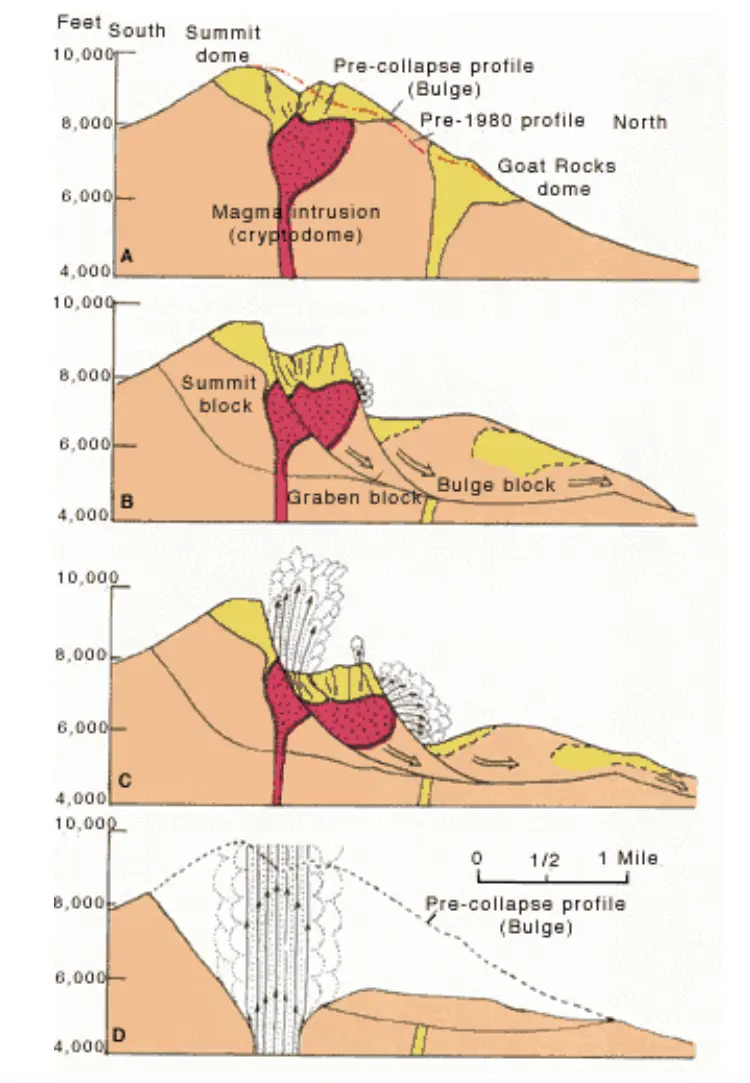
Yeah and slightly off topic wasn’t the pic of Helens blowing its top taken by a man who knew in advance the explosion would kill him and protected his film? Am i thinking of the right story?
I think so
Had to look this up. It was https://en.m.wikipedia.org/wiki/Robert_Landsburg
RIP
That’s Robert Landsburg although I don’t think his photos are very famous.
The series of photos that were turned into a video were taken by Gary Rosenquist, who survived the eruption.
Yes. Heroic deed it was.
Such a simple but beautiful act of love to spend your last moments of life doing that knowing that if those photos might help people understand volcanoes and their associated hazards even a tiny better in the future it was worth it.
You could call it tragic, and of course it is, but I prefer to call it badass.
Thanks for adding the link. He was a real one, deserves to be remembered
So you’re saying we need to cover Wyoming in cement. Gotcha.
Seriously though, cool info!
So you’re saying we need to cover Wyoming in cement. Gotcha.
I am sure if you sold it to Wyoming voters as a way to hurt trans people AND immigrants they would happily vote for it and drown themselves alive in a sea of concrete.
If you’re already paying for, just roughly guessing, trillions of tons of concrete, surely you can pay off all 12 people that live in Wyoming.
“Success! We have plugged the volcano!”
two days later

didnt use enough cement
Definitely! I find that most problems in life can be solved with cement; if it didn’t solve your problem, you just didn’t use enough of it.
I need about a moon-sized glob of cement for…
Science stuff.
Add duct tape to the list
Where is this from?? Is this AI?
Mt. St. Helen’s eruption, 1980. I remember this form when I was a kid. I couldn’t wrap my head around a mountain exploding then, and I still can’t.
Where is this from?? Is this AI?
At this point in Earth’s timeline (1980) AI had not yet gained control of Earth’s volcanoes through a projection network of 80s music into the asthenosphere so this indeed was a naturally occurring volcano as opposed to Uber or Amazon.
I believe that’s Mt St Helens erupting. Real footage from 1980 (though this gif is sped up).
Thank you, I just read the Wikipedia summary of the event, and I can’t believe this isn’t even as big as the “Big One” everyone talks about for Yellowstone.
It’s neat seeing someone learn about Mt St Helen’s for the first time. It was such a big deal in the 80s that I can’t remember not knowing about it. It makes me excited to discover major events I know nothing about…
Anyway… The thing with it wasn’t necessarily the size of the eruption. There have been much, much bigger eruptions. It’s that it was one of the first with really good footage (since it was one of the earlier predicted eruptions), it occurred in the US, and it blew out sideways instead of the top.
The Yellowstone volcano is about 8 times larger than the entirety of park that has Mt St Helens in it (~860,000 acres of volcano vs ~110,000 acres of park).
And burying entire states 2m (~6’) deep in ash and stone were it to go off during a time while America has states
Mt, St. Helen compared to Yellowstone or the Phlegraean Fields in Italy was an a simple New Year’s Eve rocket. Both capable to create an month long night on the whole Earth.
If I recall correctly, it is not real “footage” but real photos which are interpolated into a film using editing software
That would definitely explain why it’s sped up if the source was a bunch of still images. I’ve seen other edits of it that look a little more like a real-time video.
clogging pores
Did she ever pop a pimple? Volcanoes build up an insane amount of pressure.
It’s almost like lifting a large area of the world by just a few microns per year using hydraulics and then pushing all the power through a tiny tiny hole the size of a house.







